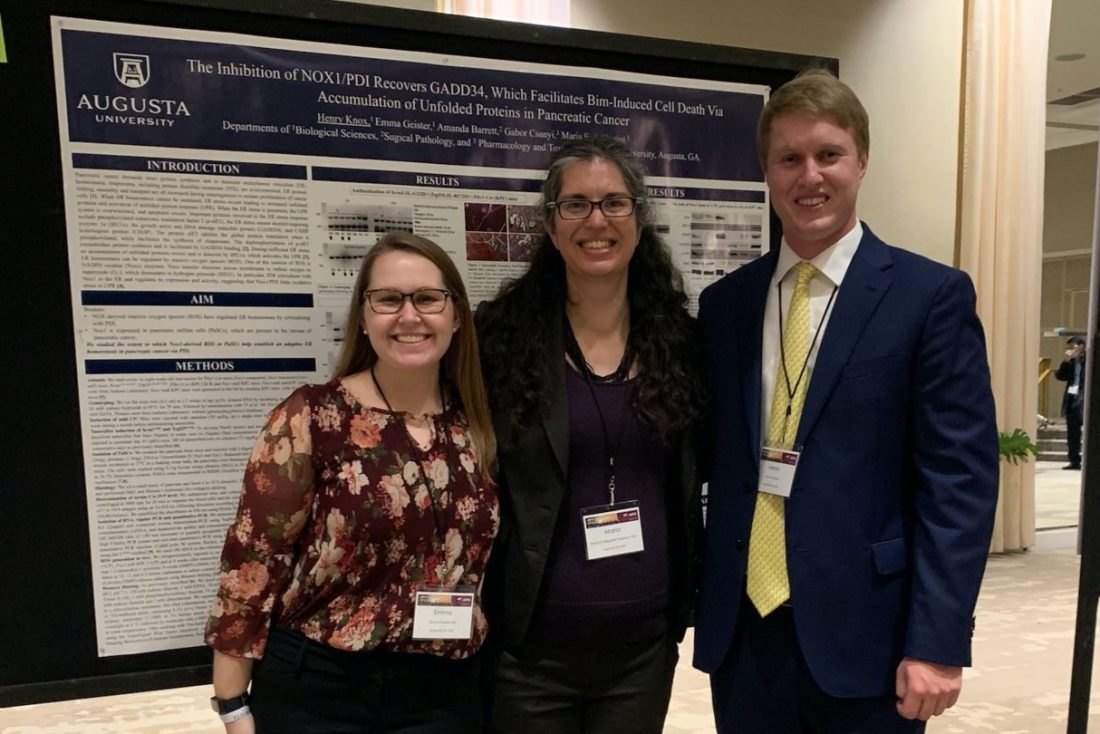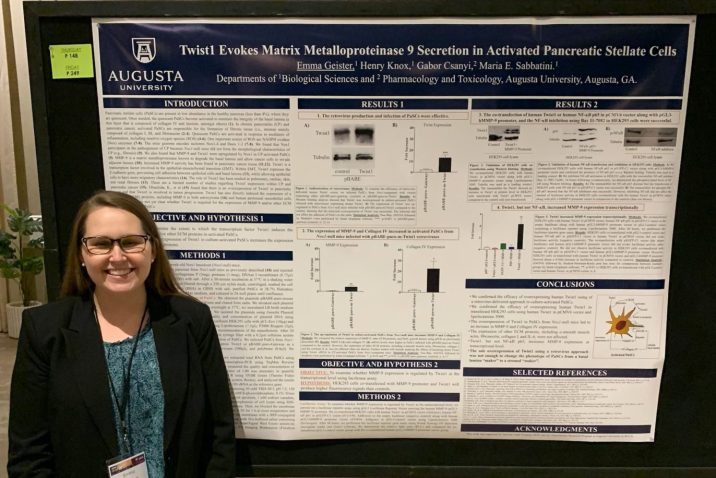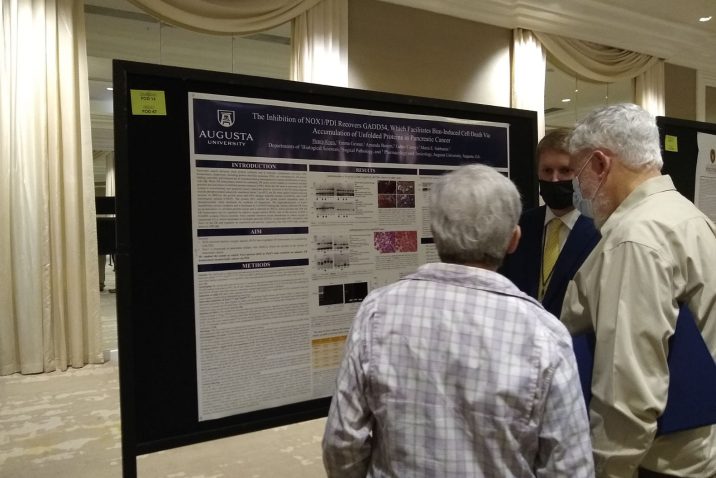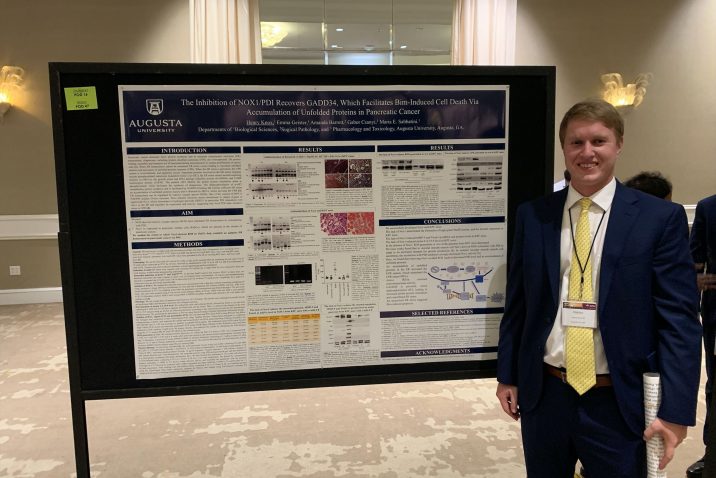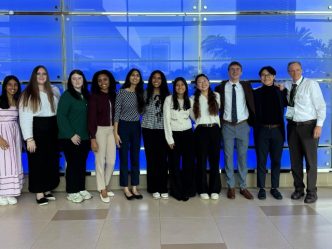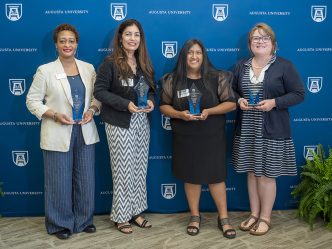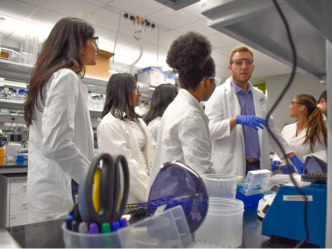Typically traveling by herself when she attends professional meetings, Dr. Maria Eugenia Sabbatini, associate professor in the Department of Biological Sciences in the College of Science and Mathematics and The Graduate School, was proud to accompany two of her students at the 2021 American Pancreatic Association Annual Meeting in Miami Beach, Florida.
Henry Knox and Emma Geister, graduate students in the biomolecular science program with a concentration in cell and molecular biology, presented two research posters at the APA meeting. While serving as their research mentor, Sabbatini facilitated their collaboration with three Medical College of Georgia faculty: Dr. Gábor Csányi from the Department of Pharmacology and Toxicology, Dr. Honglin Li from the Department of Biochemistry and Molecular Biology and Dr. Amanda Barrett from the Department of Pathology.
Sabbatini has been a regular attendee at the APA conference since 2009; however, this is the first time students have joined her. One of her students, Knox, had never attended a national conference before. Nevertheless, his poster received a rating of distinction, which acknowledges his abstract as one of the top 5% of all the poster abstracts submitted to the 2021 APA Annual Meeting.
Knox and Geister’s trip was funded by the Office of the Provost and the Translational Research Program of the Department of Medicine. They also received funding from the College of Science and Mathematics and the Graduate Student Government Association.
Knox presented his research project, “The Inhibition of NOX1/PDI Recovers GADD34, Which Facilitates Bim-Induced Cell Death Via Accumulation of Unfolded Proteins in Pancreatic Cancer,” and Geister presented her research project, “Twist1 evokes Matrix Metalloproteinase 9 Secretion in Activated Pancreatic Stellate Cells.”
Even though each of them has their own thesis per the graduate program’s requirement, the duo collaborated on each other’s research.
“I have had many successes in my thesis so far, determining that the transcription factor Twist1 in culture-activated pancreatic stellate cells induces the expression of matrix metalloproteinase-9 and collagen IV,” Geister said. “We have been able to conclude that in the healthy pancreas, Twist1 in activated pancreatic stellate cells is responsible for the synthesis and remodeling of the basal lamina.”
“Basal lamina is a layer that separates the epithelial tissue from the connective tissue, and Collagen IV is a type of collagen found primarily in the basal lamina,” Sabbatini added. She explained that Twist1, as a transcription factor, provides instructions for making proteins involved in cell invasion and development. Matrix metalloproteinases break down proteins of the extracellular environment of cells, allowing its remodeling.
Knox and Geister intend to submit the collaborated manuscripts to peer-reviewed journals for publication.
Networking and collaboration
Sabbatini believes that having students present at this meeting was an essential experience for their careers. Not only did they learn from presenting research findings to a professional audience, but they also had the chance to listen to presentations from many researchers from universities and cancer centers — including Stanford and MD Anderson Cancer Center — in which new cutting-edge techniques were presented.
“The meeting was an awesome experience for the graduate students, not only academically, but also to learn the way that they can interact and socialize with other professionals in the pancreatic research field,” Sabbatini said. “The students learn from others’ expertise; it’s also important to learn how to network with others because it impacts what they will do in the future.”
“There was abundant opportunity to network and listen to other research presentations. Communicating with other researchers and gastroenterologists from around the world allowed me to gain potential future collaborations, as well as feedback and new ideas for our research,” Geister said.
Knox expressed great appreciation for the connections he made during the conference. He was proud to be there representing Sabbatini’s lab and Augusta University.
“On multiple occasions when I met people there and told them that I worked with Dr. Sabbatini, they all recognized her because they’ve read her papers and she has been doing so much work in the field,” he said.
Lab nurtures research
Before becoming a graduate student in the biomolecular sciences program, Geister attended presentations from Augusta University’s Center for Undergraduate Research and Scholarship as an undergraduate. She saw other students’ compelling research regarding chronic pancreatitis and pancreatic cancer in Sabbatini’s lab. Seeing that her lab produces high-quality results, Geister knew she wanted to be a part of it.
Geister’s presentation to the APA was a continuation of a previous study completed in Sabbatini’s lab. Sabbatini’s manuscript, NADPH oxidase 1 mediates caerulein-induced pancreatic fibrosis in chronic pancreatitis, was published in February 2020 in the journal Free Radical Biology and Medicine.
“Dr. Sabbatini’s lab is a welcoming work environment. She is an exceptional mentor. Early on, she taught Henry and me lab techniques at the same time,” Geister said. “We all worked together on several experiments before gaining autonomy.”
Knox echoed Geister’s sentiment that Sabbatini has been an excellent mentor.
“She cares about my success in the lab and the classroom, and my personal well-being,” he said.
They believe Sabbatini’s role as their research mentor taught them to produce quality work and to go the extra mile to produce good results, hopefully leading to a better understanding of research in pancreatic cancer.
Sabbatini looks forward to advising more graduate students like Geister and Knox and collaborating with other researchers at Augusta University and across the nation. With the new CSM building opening this fall on the Health Science Campus, the proximity of research scientists in nearby buildings will continue to enhance interdisciplinary cross-pollination in research.
 Augusta University
Augusta University
